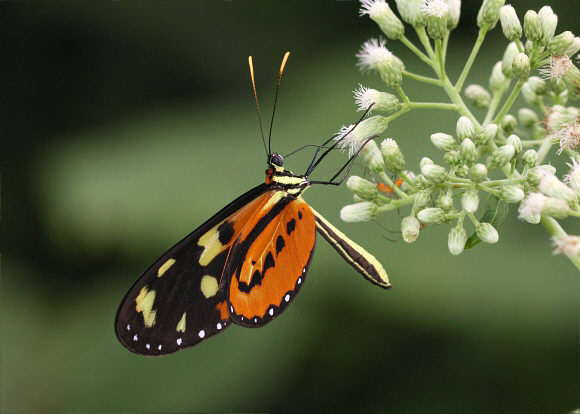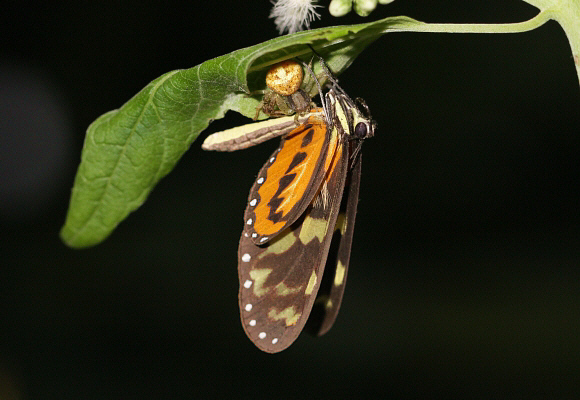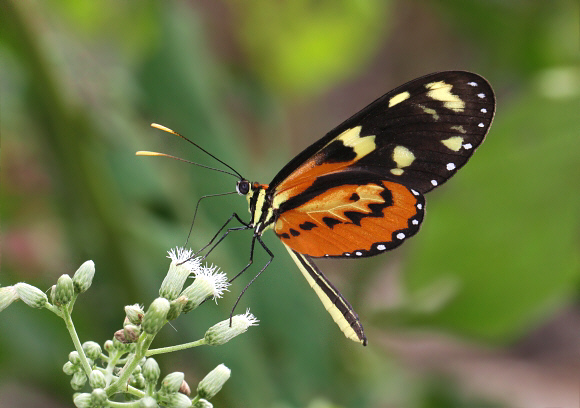
Introduction
The Ithomiini comprises of 376 known species, although it is likely that at least another 30 will be discovered in the near future. All are confined to the neotropical region. Ithomiines are unpalatable to birds, and are consequently mimicked in appearance by many other species. These include other unpalatable species ( Müllerian mimics ), not only from the Ithomiinae but also from several other butterfly families. There are also a large number of edible species ( Batesian mimics ) which have evolved similar patterns. Birds have the ability to memorise butterfly patterns and so learn to avoid eating noxious species, but are also fooled into ignoring similarly marked edible species.
Ithomiines are characterised by having small eyes, slender abdomens and long drooping antennae that lack distinct clubs. Males have a plume of long androconial scales or “hair pencils” on the costa of their hindwings. These are hidden from view when the butterflies are at rest, but are displayed when the wings are held open during courtship. Other Ithomiine characteristics include a very slow and deep wing beat, and a preference for inhabiting the darkest recesses of the forest understorey.
There are basically 2 types of Ithomiine. The first type are the black and orange-banded “tigers”, many of which are mimicked by other species due to their unpalatability to birds. The second type are the “glasswings”, recognised by their transparent or translucent wings, prominent veins, and orange wing margins. Many genera contain examples of both of these types, and in some cases an individual species may produce adults of both forms according to location.
Most novices find the Ithomiini very difficult to identify. Using only the patterns to identify species is very unreliable because there are so many similar species. Also many species produce a variety of different colour forms according to locality and season. The best approach therefore is to use the hindwing venation and other anatomical features to identify the genus, and to then look at the wing patterns to short-list the likely species.
The genus Mechanitis contains 4 medium-sized species, all of which bear superficial similarities to various members of other genera, including Melinaea, Tithorea and Forbestra, which have similar “tiger” patterning in black, orange and cream. All these species ( and other smaller Ithomiines that have similar patterns ) are toxic or unpalateable to birds. The shared pattern gives the butterflies an “advantage in numbers” because insectivorous birds learn to avoid all “tiger” species – tasting one such butterfly causes birds to vomit, and the experience is enough to convince them to leave similar looking creatures alone.
The similarity of colour and pattern doesn’t only fool the birds – it also makes it difficult for human observers to distinguish the species. In the case of Glasswings it is relatively easy to determine the genus by examining the venation, particularly that of the hindwings. It is difficult to make out the venation on Tiger-mimics however so you need to learn how to recognise other diagnostic features. These include wing shape, antennae length / colour, and the position and shape of particular spots in the discal and apical parts of the wing.
Mechanitis lysimnia is a very widespread species, distributed from southern Mexico to Uruguay. It produces at least 15 different subspecies, each varying in colour and pattern. The illustrated race elisa is restricted to the lowlands of Peru, Bolivia and the Mato Grosso in Brazil.

Habitats
Mechanitis lysimnia is found in disturbed forest habitats on both sides of the Andes, at altitudes between 0-1500m.

Lifecycle
The whitish barrel-shaped eggs are laid in batches of between 10-50 under the leaves of Solanum and possibly other members of the Solanaceae. The larvae are gregarious. When fully grown they are pale green streaked with yellow, and have a series of tubercles projecting below the spiracles. The chrysalis is silver with brown streaks on the wingpads and abdomen.

Adult behaviour
The butterfly is visible mainly in the early morning, and again in late afternoon, at which time the females can be found visiting Eupatorium flowers in forest clearings and along riverbanks. Males, in common with other Ithomiines, form “leks” to which the females are attracted by pheromones. The pheromones are disseminated by males from “hair pencils” – special androconial scales located, in the case of Mechanitis, on the costa of their upperside hindwings. These can be seen protruding in the photograph of the ambushed example at the top of the page.
In seasonal rainforests, where there are pronounced wet and dry seasons, Mechanitis gather to aestivate during the dry season at the few remaining damp areas of the forest, typically in gullies or along the beds of streams. Such places often have 100s of Glasswing and Tiger-mimics Ithomiines in residence for up to 3 months towards the end of the dry season.

